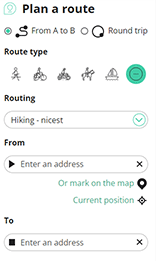

From here you have a beautiful view of the swamp where a lot of plants and animals are hidden. You will find, among other things, the cabbage white, the bald junker, water mint, giant horsetail, the mallard, hairy fireweed and atalanta.
Cabbage White:
Latin Name: Pieris Brassicae
Characteristics: They have white wings and are adorned with black dots. The wings of the butterfly are 21 to 27 mm long.
Habitat: Meadows, swampy meadow.
Food: Nectar from various flowers, including the bald junker.
Enemies: The harvestman and the ladybug eat the caterpillars.
Fun fact: Females have 2 black dots on the top of the wings, males only have one black dot.
Bald Squire:
Latin Name: cirsium palustre
Habitat: Marshes, grassland
Features: It is 60 cm to 1.5m. It is a pink purple flower with spines on the stem. He is related to the thistle.
Fun fact: The fluff has seeds and is dispersed by the wind. (as with the dandelion)
Water Mint:
Latin Name: mentha aquatica
Characteristics: The stems are 30 to 90 cm long. The flowers are purple.
Habitat: The plant grows mainly along and in water and in wet meadows.
Flower: The flowers are beautifully round and rose purple.
Reproduction: Insect bloomer
Fun fact: When you rub the leaves, they smell like peppermint.
Giant Horsetail:
Latin Name: equisetum telmateia
Habitat: Mostly on wet, moderately nutrient-rich soil.
Characteristics: Pale white stem about 1 cm thick. The weeds are also often in our garden.
Flower: The leaf whorls are light green, but brown at the top. The teeth do not hang together.
Reproduction: Recreates with spores.
Fun fact: The root can go up to 4 meters deep.
A giant horse's tail can grow up to 30 cm to 1.8 meters!
The Mallard:
Latin Name: anas platyrhynchos
Characteristics: The females are brown, the males have a green head.
Habitat: The mallard can be found in almost every aquatic environment.
Food: Acorns in winter and grasses. Also bread that is fed by the people.
Threat - enemies: Humans and foxes are enemies of the mallard.
Defense: The mallard croaks to scare off and bites to weaken.
Fun fact: There are 350,000 to 500,000 breeding pairs. Mallards live together as a 'couple'. Animals are often used in fairy tales. Do you know the fairy tale of 'The Ugly Duckling'?
Hairy fireweed:
Latin Name: epilobium hirsutum
Features: Can reach a height of 0.8 to 1.8 m.
Habitat: Sunny to semi-shaded sites on moist to mostly wet, nutrient-rich to very nutrient-rich soil. Waterfronts, springs, marshes, railway embankments, canal embankments, public gardens, sea dunes, forest edges and vegetable gardens.
Flower: Purple-red flowers that are 2 to 3 cm in size.
Fun fact: Once upon a time, a group of fairies lived under a bush of pink roses. Nearby, in the hollow trunk of an old pollard willow, lived a family of gnomes. One day, an elf girl and a leprechaun boy fell in love with each other. They wanted nothing more than to marry each other, but despite quarrels and pleading, both families remained inexorable: elves and leprechauns do not marry each other. Period.
But the leprechaun and the fairy girl kept secretly meeting each other. The tribal elders of both families finally decided, that if the two lovers really wanted to choose to marry each other,
that they would lose their elven and leprechaun form forever. And so it came about that out of the love of the goblin and the fairy a new plant arose, which bore flowers with the
color of the roses of the fairy family and with the narrow petals and the seed fluff of the willow where the gnomes had their ancestral home...
Red admiral:
Latin Name: vanessa atalanta
Characteristics: Striking migratory butterfly with a wingspan of 5-6 cm. The ground color is yellowish
gray to black with yellowish-white spots on the sides.
Habitat: The special feature of the atalanta is that it is a migratory butterfly. Every year the atalanta flies from southern Europe to the north. The atalanta lives mainly around the Nettle.
Food: They live mainly on nectar, but also on tree sap and rotting fruit. Nectar plants are diverse, such as flowering privet and ivy, Buddleja, celestial key, and so on. They lick up the nectar with their long rolling tongue that is normally rolled up.
Threat - enemies: Because the atalanta is a migratory butterfly, many butterflies die
during their journey. Especially on the Pyrenees, many butterflies die.
Fun fact: The eggs are deposited one by one on the nettle to
protection. This butterfly can survive at an altitude of more than 2000 meters.
 Azure
Azure![]() | | Public | Danish • Dutch • French • German • Italian • Spanish
| | Public | Danish • Dutch • French • German • Italian • Spanish

Select one of the most popular activities below or refine your search.
Discover the most beautiful and popular trails in the area, carefully bundled into appropriate selections.
Select one of the most popular categories below or be inspired by our selections.
Discover the most beautiful and popular attractions in the area, carefully bundled in appropriate selections.
With RouteYou, it's easy to create your own customised maps. Simply plot your route, add waypoints or nodes, add places of interest and places to eat and drink, and then easily share it with your family and friends.
Route planner

<iframe src="https://plugin.routeyou.com/poiviewer/free/?language=en&params.poi.id=1408437" width="100%" height="600" frameborder="0" allowfullscreen></iframe>
© 2006-2025 RouteYou - www.routeyou.com